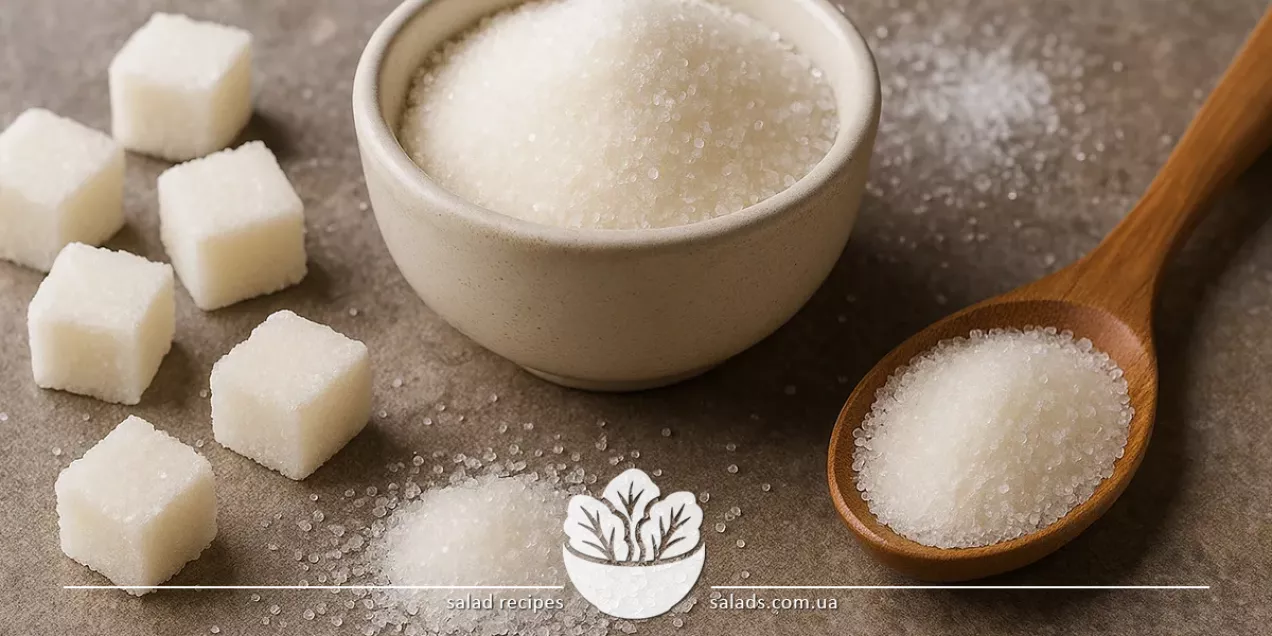
White Sugar

White sugar is the most common type of sweetener used in cooking, beverages, baking, and desserts. It has a crystalline structure, high solubility, and a clean sweet taste without additional aromatic notes. Sugar performs not only a flavoring role but also a technological one: it creates crusts in cookies, enhances the aroma of spices, and stabilizes proteins and creams. Its presence in a recipe is often critical for success. You can find more about other forms of sugar in the corresponding section.
Salad Recipes with White Sugar
Flavor, Texture, and Culinary Function of Sugar
White sugar is not just a sweet component, but a full-fledged regulator of flavor and texture. It balances acidic and bitter notes, highlights spice aromas, and stabilizes the consistency of liquid ingredients. In sauces and dressings, sugar softens acidity – such as that of tomato juice or vinegar – while in desserts it unites flavor elements into a harmonious composition. Beyond taste, sugar plays a key role in dish structure. In baked goods, it forms a caramelized crust, contributes to airy dough by binding water and forming steam, and influences browning and texture. In foams, meringues, and creams, it stabilizes proteins and creates a glossy, dense texture. Sugar also slows protein coagulation, which is especially important in delicate desserts and drinks. In beverages, sugar not only adds sweetness but also serves as a solvent for aromatic substances: tea, coffee, herbs, and spices. Its ability to dissolve instantly – even in cold water – makes it convenient for everyday use. In preserving and syrups, it also acts as a preservative by limiting bacterial and fungal activity.
Origin, Production, and Types of White Sugar
White sugar is most often made from sugar beet or sugarcane. Both sources contain sucrose, which is extracted and purified in multiple stages. In beet sugar production, the juice is first purified from impurities, then evaporated into syrup and crystallized. Cane sugar generally has slightly larger crystals and may be refined or unrefined – the latter retains some molasses and has a caramel note. White sugar sold in stores is a purified, fine-crystalline product with more than 99% sucrose. It has no smell, dissolves easily in water, and is widely used in both home cooking and the food industry. There are several types of white sugar – regular granulated, fine-grain (caster sugar), powdered sugar – that differ in grind size and application. When cooking, it's important to consider sugar properties: fine sugar dissolves faster and is better for whipping egg whites or cream, while regular sugar is ideal for dough, marinades, and beverages. Some recipes require precise texture, so the type of sugar can influence the final result.
Sugar in Baking: From Dough to Decoration
In baking, white sugar performs several important functions at once: it sweetens, creates crusts, affects dough volume, and stabilizes proteins. When creamed with fat and air, sugar helps form a fluffy dough structure; when heated, it caramelizes, creating a crispy golden surface. It is essential in sponge cakes, muffins, cookies, rolls, pastries, and even some types of bread. Sugar also helps form the proper consistency. In yeast dough, it serves as “food” for the yeast, helping activate fermentation, speed up rising, and shape the texture. In choux pastry, it dissolves in liquid and supports emulsion stability. In shortcrust pastry, the amount of sugar directly affects the crispness and crumbly texture of the finished product. Decorating baked goods is also closely tied to white sugar: it is used to make powdered sugar, syrups, icing, and caramel. Combined with other ingredients, sugar adds visual appeal – glossy crusts on muffins, shiny glaze on cookies, or sugar figurines on cakes – all of these are impossible without high-quality white sugar.
Sugar in Beverages, Desserts, and Preserving
White sugar is widely used in preparing drinks such as tea, coffee, cocoa, stewed fruit, compotes, lemonades, and cold cocktails. Thanks to its high solubility, it easily blends with liquids of any temperature. In hot drinks, it balances astringency or acidity; in cold drinks, it adds richness and makes the flavor smoother and more pleasant. In desserts, white sugar is one of the main ingredients. It is added to creams, mousses, soufflés, puddings, ice cream, and jellies. During syrup cooking, sugar ensures a stable texture and allows control over the final consistency. The right concentration of sugar defines the final dessert structure – from airy and light to chewy caramel. In preserving, sugar acts as a natural preservative. It is added to jams, preserves, syrups, and candied fruits to keep products fresh without artificial additives. Due to its high osmotic activity, sugar draws water from fruits and suppresses bacterial growth. This not only prolongs shelf life but also preserves the fruit’s color, aroma, and flavor.
Alternatives to White Sugar and Modern Approaches
Although white sugar remains the standard in cooking, more and more people seek alternatives – for health, taste, or dietary reasons. Among natural substitutes, the most popular are honey, maple syrup, coconut sugar, and unrefined cane sugar. They have more complex aromas, contain trace elements, and have a lower glycemic index – though they are still carbohydrate sources. Artificial and semi-synthetic sweeteners such as aspartame, sucralose, stevia, and erythritol are widely used in recipes for diabetics or low-calorie diets. However, they cannot always replace sugar in baking or caramelization, as not all are heat-stable or capable of producing the right texture. In everyday cooking, sugar is still irreplaceable thanks to its technological properties. Modern recipes increasingly combine sugar with other natural ingredients to reduce overall sweetness or enrich dishes with nutrients. At home, sugar amounts in recipes can be gradually reduced – this helps adapt taste receptors and lower sugar intake without losing pleasure from favorite dishes.